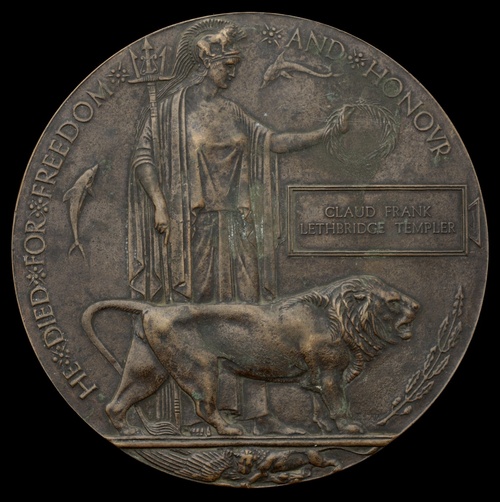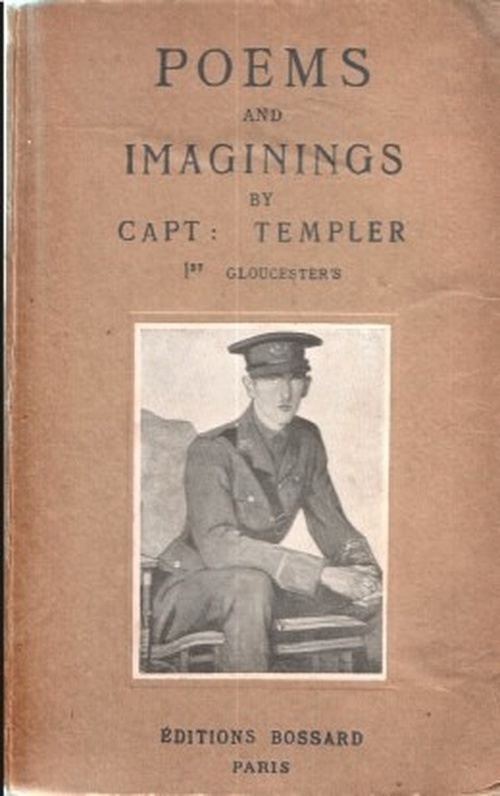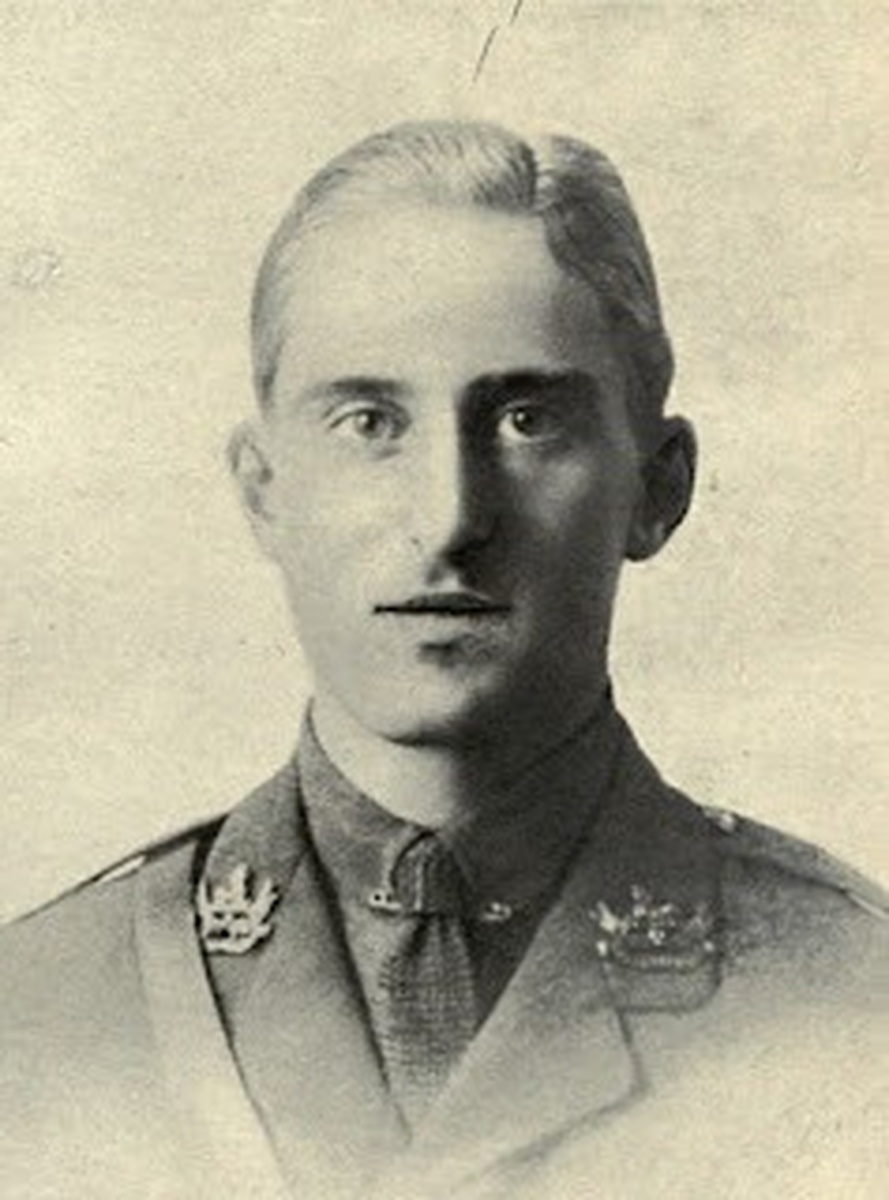Auction: 22003 - Orders, Decorations and Medals
Lot: 160
'I resolve to be a worthy warrior. To fight to the finish, to love to the finish, to sacrifice everything but never honour. And to do all this with no hope of payment, but as a volunteer, just for the beautiful poetry of it all.'
Lieutenant Claude Templer, writing home from the Western Front in April 1918.
The important Great War memorial plaque issued in remembrance of the war poet Lieutenant Claude Templer, The Gloucestershire Regiment, who was killed in action on 4 June 1918
His poetry aside, Templer is best known for his unrelenting determination to escape his captors after being taken prisoner of war in December 1914. After no less than 12 attempts, he finally made it to Holland in June 1917, swimming the river Ems with two fellow officers, one of them, an old school friend, Lieutenant Gilbert Insall, V.C.
In the interim he had swung a bottle at a pursuing German and attacked one of his guards with his bare fists, grim determination that found him regularly confined to cramped cells with 'no exercise, no parcels and no smokes'. One such cell was just a yard wide.
News of Templer's extraordinary exploits and escape quickly hit the home press, so much so that His Majesty the King requested a private interview with him
Later still, the Germans returned a quantity of Templer's notebooks and papers to his family, and from them emerged an account of his defiance as a prisoner, together with examples of his poetry and short stories
Poems and Imaginings was duly published in 1919 and gained a wide and admiring audience. Two years later the section of the book dedicated to his escaping activities was republished as an official government pamphlet - entitled Behind German Lines - for it was felt it recorded 'a splendid example of courage, self-sacrifice and determination'
Memorial Plaque 1914-18 (Claude Frank Lethbridge Templer), good very fine
Claude Frank Lethbridge Templer was born in Dharmsala, Punjab, India on 5 July 1895, the son of Colonel Henry Templer, late of the 5th Punjab Cavalry. He was educated at Wellington College, the Anglo-Saxon School in Paris and the Royal Military College Sandhurst.
A cadet at Sandhurst when the war broke out, he was commissioned in November 1914 and joined the 1st Battalion of the Gloucestershire Regiment on the Western Front. Captured during a raid on German trenches at La Bassee on 22nd December 1914, he was to spend two and a half years in captivity in Germany.
A good summary of his subsequent escapes appears on the 'Behind Their Lines' website, under the title 'The Losing Fight' (June, 2018):
'First taken to Lille, he was sent to the German POW camp at Hanover-Münder, "suffering from concussion and slight shrapnel wounds in his legs which had festered owing to neglect and blood-poisoning caused by the disgusting quality of the extremely insufficient food provided."
By April of 1915, he had recovered and planned an escape attempt with 7 Russian officers. The men dug a hole in the wall of the former factory where they were being held and crawled through an air shaft that exited beyond the barbed wire of the camp. They were free for a week and had nearly reached the Dutch border before they encountered "some peasants who regarded them with suspicion," whereby "one of the Russian officers lost his nerve and shrieked and ran away." Chased by villagers, Templer ran for two miles until caught from behind. Swinging at his pursuer with an empty bottle, Templer was nearly lynched by the crowd, and was saved only by the appearance of a policeman who took him into custody.
Moved to Bischofswerda and then Torgua camp, he plotted escape attempts at each location, but was transferred before he was able to put them into action. Arriving at Burg Camp, he immediately began to dig a tunnel. He worked with another British officer, but their plan was discovered in September of 1915, and they were sentenced to Burg Gaol for one year and one week "for damage to public property and the theft of a plank."
Templer attempted four escapes from Burg Gaol: "contriving to steal keys," he escaped into town before he was recaptured. Then working with others to craft skeleton keys, a group of men escaped from their cells to the roof, where they attached a rope made of torn sheets to a chimney. The makeshift rope broke, sending one of the men plummeting into a water-butt in the courtyard below, and the plot was discovered. Templer also attempted to escape by sawing through the iron bars of his cell window and by drugging the gaoler, "but owing to the inferior quality of the drug, this also proved a failure." As punishment for his persistent defiance, he was transferred to Magdeburg Civil Gaol, where he helped another officer to escape, despite his own confinement in a cell one yard wide by four yards long.
Transferred again in April 1916 to the fortress at Wesell, his escape attempt only got him as far as the moat. Ordered back to Magdeburg Camp under guard, Templer took advantage of a stop at a rural train station, attacked his guard, vaulted over a wall, stole a bicycle, and "scorched down the road for dear life." Putting fifteen miles between himself and his pursuers, he concealed the bicycle in undergrowth and hid in a wood near the Dutch border. Twenty-four hours later, he was recaptured, taken to Burg camp and again court-martialled. While the Germans complimented him for his "military method of escape," they imprisoned Templer again in a cramped cell at the prison, this time with "no exercise, no parcels and no smokes." After serving his time, he was again returned to Magdeburg camp, where he again began to tunnel.
While waiting for his own opportunity to gain freedom, he assisted in another British officer's escape plan, creating a forged pass. In March of 1917, along with all British officers, Templer was transferred to Augustabad Camp. Held in a lodge outside camp for his failure to comply with camp discipline, Templer tried to escape by removing shutters from the windows, only to find a sentry waiting for him with a fixed bayonet. Undeterred, he tried again the following night, this time eluding the guard and putting as much distance between himself and the camp as he could until he was able to hop aboard a cargo train. Attempting to jump from the train as it neared a station, he sprained his ankle and was recaptured.
Transferred to a camp at Ströhen on June 10, 1917, Templer was imprisoned for five weeks. When released in mid-July, he immediately planned an escape with two other British officers. Tunnelling through the floor of the camp bathroom to the barn-outhouse that lay below, the men slipped into the lower barn on August 20th, supplied with food, compasses, and a small map. They remained there until dark, when alerted to their absence, the Camp Commandant arrived where they had last been seen - the bathroom. Unaware that the men were hiding just below in the barn, the Commandant gave search parties specific directions for the hunt - detailed instructions that the men were able to overhear.
Under cover of a violent rainstorm during that night, silently in stockinged feet, the men crept past a sentry who had taken shelter in the entrance of the barn. Knowing where the search would be made, they eluded patrols, and travelled nine nights until reaching the Dutch frontier. Along the way, the escapees were nearly attacked by a bull as they attempted to milk a cow in a field. Swimming the river Ems at midnight and crawling through barbed wire fences on the other side, they finally reached freedom. Returning to England in September of 1917, the escapees sent the Commandant at Ströhen "a post-card assuring him of their safe arrival and asking him if he 'would be kind enough to forward on their letters to the new address!'"
Almost immediately, Templer requested permission to rejoin his regiment; he returned to France in late March of 1918. On the night of June 4th, he organized and led his men on a raid on the German trenches, and returning to the British lines with "his victorious company," Captain Claude Templer "was struck by a chance shell and instantaneously killed on the field of honour." The Germans returned approximately one-third of Templer's POW writings; among them was the following poem:
The Losing Fight
If fortune knocks you down and has you beat,
Don't give up hope. Don't strike that Kismet pose,
But keep your head and get up on your feet
For fortune's blows must be returned by blows.
Destiny at the finish of your fight
Awards the irrevocable decree,
And it is only then that you'll be right
In saying, "I must bow to destiny".
Therefore fight on until the closing day,
No matter if your cause be won or lost.
'Tis not defeat or triumph, but the way
In which you've fought your fight that matters most.
Fight on and may it be your joy to see
Dawn pressing hard upon the heels of night;
They only gain the final victory
Who learn the way to fight the losing fight.
Two months before his death, in April of 1918, shortly after returning to the Western Front, twenty-two-year-old Claude Templer, wrote in a letter home, "I resolve to be a worthy warrior. To fight to the finish, to love to the finish, to sacrifice everything but never honour. And to do all this with no hope of payment, but as a volunteer, just for the beautiful poetry of it all." His name appears on the Loos Memorial to the Missing.'
Postscript
The Templer family website has a copy of his extensive official P.O.W. report, in addition to a copy of Poems and Imaginings;
http://www.templerfamily.co.uk/Claude%20F%20L%20Templer%20POW%20Report.pdf
And Templer's alma mater Wellington College has a dedicated entry on its website, which includes a complete copy of Behind German Lines:
https://memorial.wellingtoncollege.org.uk/Filename.ashx?tableName=ta_wellingtoniansatwar&columnName=filename&recordId=31
A memorial plaque to Templer is to be found in the chapel at the R.M.C. Sandhurst:
'To the glory of God and in proud memory of Claude Templer, Captain, 1st Bn The Gloucestershire Regiment. Wounded and captured 22nd December 1914. Escaped from captivity in Strohen, 29th September 1917, after having made 12 previous attempts from the prison camps at Hanover, Munden, Torgau, Burg (twice), Magdeburg, Augustabad, from the Burg Civil Goal (4 times), the Fortress of Wesel, twice whilst travelling under escort between Wesel and Magdeburg. Rejoined his regiment at his own special request 29th March 1918. Killed by a chance shell whilst returning from a successful raid on the German trenches in the La Bassee Sector, 4th June 1918, in his 23rd year.'
Subject to 20% VAT on Buyer’s Premium. For more information please view Terms and Conditions for Buyers.
Sold for
£650
Starting price
£350









